Abstract
A model examining the National Water Wealth (NWW) and its allocation between the municipal sector and the agricultural sector, where water value is defined as the present value of Water Rights, is presented. Five factors are considered: (i) uncertainty of water supply; (ii) population growth rate; (iii) the effect of time on NWW without new water production; (iv) agency costs, and; (v) production of new waters. The work is based on the model by Jensen and Meckling (J Finance Econ. 3:305–360, 1976), dealing with the effects of agency costs on the value of public companies. Agency costs are subject to conflicting interests between managers, shareholders and bondholders. In the water economy agency, costs stem from a divergence of interests between the government, the agricultural and the municipal sectors. Uncertainty of supply reduces water wealth of both sectors, with a stronger adverse impact on water wealth of the agricultural sector. Our model shows how production of new waters can have contributive effects on national water wealth. The modeling demonstrates the option of reducing the overall uncertainty of water supply and production of new waters which leads to favorable effects on the national water wealth.



Similar content being viewed by others
Abbreviations
- Cpdt :
-
Agency costs of debt
- Cpgt :
-
Agency costs of owner’s equity
- Cptt :
-
Total agency costs
- Egwrt :
-
Expected groundwater recharge quantity
- F:
-
The extent of the Water Commissioner’s lack of identification with the agricultural sector
- Fx:
-
Maximal F for each period
- Jr:
-
Constant ratio between the average discount rate for the two sectors (Rvt) and the discount rate of the municipal sector (Rmt)
- Lunt :
-
Relative uncertainty of supply imposed on the agricultural
- Nwht :
-
It is Nwwt including the present value of desalination
- Nwwt :
-
National Water Wealth
- Nwwt (Cptt):
-
NWW assuming agency costs
- Pg:
-
Fixed positive rate of population growth
- Qht :
-
Present value of desalination
- Qhyt :
-
Annual constant average quantities of water generated from desalination
- Qmt :
-
Water allocation for the municipal sector
- Ragt (Cpgt):
-
Discount rate of the agricultural sector assuming agency costs of owner’s equity
- Rat :
-
Discount rate of the agricultural sector
- Rft :
-
Risk-free discount rate
- Rht :
-
Discount rate of desalination
- Rmt :
-
Discount rate of the municipal sector
- Rmt(Cpdt):
-
Discount rate of the municipal sector assuming agency costs of debt
- Rvt :
-
Weighted average discount rate of the two sectors
- Rvt(Cptt):
-
Weighted average discount rate of the two sectors assuming agency costs
- Va:
-
constant quantity of water per period allocated to the agricultural sector from the period t+1 onwards
- Va(Cpgt):
-
Fixed average amount of water allocation per period (assuming agency costs of owner’s equity) for the agricultural sector from period t+1 onwards
- Vgt :
-
Water quantity that the Water Commissioner sees as “his own”
- Vot :
-
Water quantity that the Water Commissioner does not see as “his own”
- Vot(Cpgt):
-
Water wealth of the agricultural sector assuming agency costs of owner’s equity
- Wsat :
-
Agricultural sector’s share in Nwwt
- Wsmt :
-
Municipal sector’s share in Nwwt
- Wwat :
-
Residual water wealth of the agricultural sector
- Wwat (Cpgt):
-
Residual water wealth of the agricultural sector
- Wwht :
-
The weight of water wealth stemming from desalination out of NWW
- Wwmt :
-
Water wealth of the municipal sector
- Wwmt(Cpdt):
-
Water wealth of the municipal sector assuming agency costs of debt
- Wwht :
-
The weight of natural water wealth out of NWW (including desalination)
- α:
-
Water Commissioner’s relative identification with the agricultural sector
- β:
-
Fixed positive coefficient
- γ:
-
Fixed positive coefficient relation between μd and μg
- ρ:
-
Fixed positive coefficient
- μd :
-
Fixed positive constant
- μg :
-
Fixed positive constant
References
Abufayed AA (2001) Desalination: a viable supplemental source of water for the arid states of North Africa. Desalination 139:297
Abdulrazzaks MJ (1995) Water supplies versus demand in countries of Arabian peninsula. J of Water Resour Plan and Manag 121:227–234
Barker R, Scott CA, De Fraiture C, Amarasinghe U (2000) Global water shortages and the challenges facing Mexico. Int J Water Resour Dev 16(4):525–542
Bdour AN, Moshrik R, Hamdi R, Tarawneh Z (2009) Perspectives on sustainable wastewater treatment technologies and reuse options in the urban areas of the Mediterranean region. Desalination 237(1–33):162–174
Butterworth J, Ducrot R, Faysse N, and Janakarajan S (eds) (2007) Peri-urban Water conflicts supporting dialogue and negotiation. Technical paper series 50, IRC international Water and Sanitation Centre, Delft, The Netherlands
Carr GR, Potter B, Nortcliff S (2011) Water reuse for irrigation in Jordan: perceptions of water quality among farmers. Agric Water Manag 98(5):847–854
Characklis GW, Griffin RC, Bedient BP (1999) Improving the ability of a water market to efficiently manage drought. Water Resour Res 35(3):823–831
Charalambous CN (2001) Water management under drought conditions. Desalination 138:3–6
Colin F, Guillaume S, Tisseyre B (2011) Small catchment agricultural management using decision variables defined at catchment scale and a fuzzy rule-based system: a Mediterranean vineyard case study. Water Resour Manag 25:2649–2668
Dinar A, Rosegrant MW, Meinzen-Dick R (1997) Water allocation mechanisms: principles and examples. Policy research working, paper No. WPS1779, Agriculture and Natural Resources Department, Sector Policy and Water Resources Division, World Bank, 1818 H street NW, Washington DC 20433, p–36
Dogra P, Sharda VN, Ojasvi PR, Prasher SO, Patel RM (2014) Compromise programming based model for augmenting food production with minimum water allocation in a watershed: a case study in the Indian Himalayas. Water Resour Manag 28:5247–5265
Gordon MJ, Shapiro E (1956) Capital equipment analysis: the required rate of profit. Manag Sci 3:102–110
Greenberg MR (2009) Water, conflicts and hopes. Am J Public Health 99(11):1928–1930
Haro D, Paredes J, Solera A, Andreu J (2012) A model for solving the optimal water allocation Problem in river basins with network flow programming when introducing non-linarites. Water Resour Manag 26:4059–4071
Harris M, Raviv A (1991) The theory of capital structure. J Financ 46:297–355
Hoyer B (2010) Water rights and allocation. DNR, Iowa Water Plan, Iowa Department of Natural Resources (IDNR), Des-Moines, Iowa, p 20
Jensen MC (1986) Agency costs of free cash flow, corporate finance, and takeovers. Am Econ Rev 76:323–329
Jensen MC, Meckling WH (1976) Theory of the firm: managerial behavior, agency costs and ownership structure. J Financ Econ 3:305–360
Johansson RC, Tsur Y, Terry LR, Doukkali R, Dinar A (2002) Pricing irrigation water: a review of theory and practice. Water Policy 4:173–199
Llamas MR, Martinez-Santos P (2005) Intensive groundwater use: silent revolution and potential source of social conflicts. J Water Resour Plan Manag 131(5):337–341
Lopez-Gunn E, Zorrilla P, Prietod F, Llamas MR (2012) Lost in translation? Water efficiency in spanish agriculture. Agric Water Manag 108:83–95
Megdal SB, Hamann R, Harter T, Jawitz JW, Jess JM (2009) Water, people, and the future: water availability for agriculture in the United States. Council for Agricultural Science and Technology (CAST). Issue paper 44. CAST, Ames, Iowa, USA, p 20
Molle F, and Berkoff J (2006) Cities versus agriculture: revisiting inter sectorial water transfers, potential gains and conflicts. Research Report No. 10. IWMI international Water Management Institute, IWMI, P.O. Box 2075, Colombo, Sri Lanka, p 72
Molnar JL, Kubiszewski I (2012) Managing natural wealth: research and implementation of ecosystem services in the United States and Canada. Ecosyst Serv 2:45–53
Nikouei A, Ward FA (2013) Pricing irrigation water for drought adaptation in Iran. J Hydrol 503:29–46
Perret SR (2002) Water policies and smallholding irrigation schemes in South Africa: a history and new institutional challenges. Water Policy 4:283–300
Rogers P (2008) Facing freshwater crisis. Scientific American 299, August 2008, 46–53
Rogers P, de Silva R, Bhatia R (2002) Water is an economic good: how to use prices to promote equity, efficiency, and sustainability. Water Policy 4:1–17
Ryu JH, Palmer RN, Jeong S, Lee JH, Kim Y-O (2009) Sustainable water resources management in a conflict resolution framework. J Am Water Resour Assoc 45(2):485–499
Shannon MA, Bohn PW, Elimelech M, Georgiadis JG, Mariñas BJ, Mayes AM (2008) Science and technology for water purification in the coming decades. Nature 452:301–310
US Supreme Court, The case of Winters vs. United States, 207 US 564 (1993) Ecology v. Yakima reservation irrig. dist., 121 Wn.2d 257, P.2d 1306.
Suweis S, Rinaldo-Martin A, D’Odorico P (2012) Water-controlled wealth of nations. Natl Acad Sci U S A 110(11):4230–4233
Vos J, Boelens R (2014) Sustainability standards and the water question. Dev Chang 45(2):205–230
World Bank (1999) Accelerating China’s rural transformation. The World Bank, Washington DC, p 132
Yang H, Zhang X, Zehnder AJB (2003) Water scarcity, pricing mechanism and institutional reform in northern China irrigated agriculture. Agric Water Manag 61:143–161
Yang H, Pfister S, Bhaduri A (2013) Accounting for a scarce resource: virtual water and water footprint in the global water system. Curr Opin Environ Sustain 5:599–606
Yaron D (1994) An approach to the problem of water allocation to Israel and the Palestinian entity. J Environ Econ Manag 42:271–286
Zhao J, Cai X, Wang Z (2013) Comparing administered and market-based water allocation systems through a consistent agent-based modeling framework. J Environ Manage 123:120–130
Zhuang Y, Zhang Q (2015) Evaluating municipal water management options with the incorporation of water quality and energy consumption. Water Resour Manag 29:35–61
Author information
Authors and Affiliations
Corresponding author
Additional information
Erez Braude passed away.
Rights and permissions
About this article
Cite this article
Braude, E., Hauser, S., Sinuany-Stern, Z. et al. Water Allocation Between the Agricultural and the Municipal Sectors Under Scarcity: A Financial Approach Analysis. Water Resour Manage 29, 3481–3501 (2015). https://doi.org/10.1007/s11269-015-0986-y
Received:
Accepted:
Published:
Issue Date:
DOI: https://doi.org/10.1007/s11269-015-0986-y




